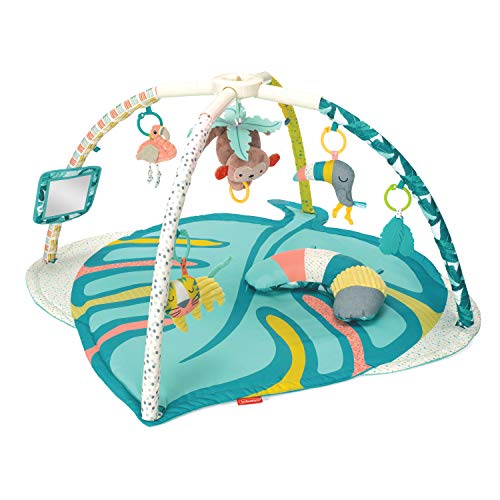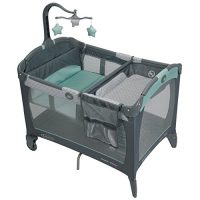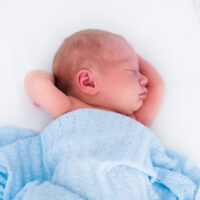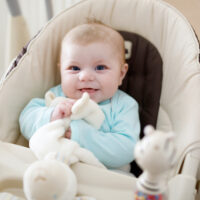Many parents dread their infant’s 4-month old milestone. Why? It’s when your previous “great sleeper” turns into a hungry, grumpy, sleep-avoiding monster! Experts call it sleep regression, also known as sleep-deprived-mom torture. While this period may be difficult, it’s a normal part of infant growth and development.
Knowing when sleep regression strikes can help you to prepare for it. Here is everything you should know about it, including when to expect it. We cover how to identify and manage sleep regression at various ages, and answer all of your questions in one handy-dandy article.
What is Sleep Regression?
Picture this scenario: Your baby is still awake two hours past her normal bedtime… two hours! This equates to two loads of laundry, a plate of food, dishwasher loading, and bathroom time without a baby in a bouncy seat in front of you. You needed those two hours that your baby “stole” from you.
Dramatic right? Overtired moms who spend all day caring for the needs of others become a little desperate for some self-care time. So, why is your baby punishing you by sleeping less? Is the baby doing this on purpose to take away your last shred of energy?

Trust me. Your baby is not purposefully taking away your precious alone time, or causing you to lose sleep. Your little one is growing, and with growth comes new sleep patterns. As babies mature, their sleeping patterns change as well. From birth to age three months, it is common for infants to nap up to three hours between feedings (source). This sleep pattern changes, however, around four months old. Naps become shorter, and some infants may begin to sleep six to eight hours at night (source). But then, a baby who had been sleeping through the night suddenly begins to wake frequently or refuse to take a daytime nap.
And here you were all excited to have that dream baby who slept through the night at four weeks old, only to now have a four month old who wakes you up every two hours!
Sleep regression is an inaccurate name. Babies who change their sleep habits are not regressing from good to bad sleep habits, but instead transitioning to new sleep patterns that are expected to occur with growth. During this transition, the lower part of the brain, called the brain stem, is developing nerve connections that affect an infant’s sleep cycle (source). A sleep transition can take two to six weeks before an infant settles back into a routine.
In the meantime, you and baby may become irritable during this shift. Not only is your little one sleeping less at night, but he or she is taking shorter naps. This translates to fewer chores done, less time for the needs of siblings, and less sleep for you, and no time to just have a few minutes for yourself.
Symptoms of Sleep Regression
How to spot sleep regression in your baby:
- Decreased sleep
- Increased fussiness or crankiness
- Shorter or fewer naps
- Increased hunger
- Increase clinginess (for the baby, not for you)
- Baby is 4 months or older
- Baby is no longer sleeping through noises
- Baby is waking more easily
- The waking is not because of hunger, teething, or illness
If your infant is experiencing any of these systems, chances are that they are in the midst of a sleep regression (source). Lucky you!
Sleep Regression Ages: How to Cope
The first year of a baby’s life is also when the most growth occurs. Each month has its own expected developmental milestones and triggers for shifts in sleep patterns. The onset of sleep regression can vary, but it tends to occur at or around 4 months, 6 months, 8 months, 12 months, 18 months, and age 2.
Not every baby will experience a change in sleep patterns at each of these ages. Your baby might only have a 4-month and a 12-month regression, only an eight month one, or regression at six stages. Let’s look at each age, and how to manage them.
Don’t worry that sleep regression is brought on by any decisions about your infant’s sleep habits such as whether or not you chose to use a co-sleeper . The exact causes of sleep regression are not completely understood (source).
4 Month Sleep Regression
Congratulations on reachng the four-month stage! Your little bundle of joy is no longer a newborn! Newborns fill their days with eating, sleeping, pooping, peeing, and crying. That’s it.
Now, because your baby, is older she can do more. She can look at the world around her and explore. At this age, she is aware that she can control her little body, including her arms and legs. Most of these babies begin rolling over from their stomachs to their backs (source). Others rolled over for the first time months ago, but now are learning to control their ability to roll.
Either way, life was pretty one dimensional for your newborn. Now that your baby is older, she is more aware of her surroundings, and she, naturally, wants to examine everything!
Your baby will now stay awake longer between naps to have time to investigate their world. As a newborn your little girl was asleep more than she was awake. Now, you can expect her to remain awake for more hours during the day as she only needs 12 to 15 hours of sleep (source).
Let Your Baby Explore and Play
By four months old, babies want to explore and move. Now is the time to let your baby play. They are curious about moving their little bodies, and discovering their hands and feet. Give them time and an opportunity to explore; that means more belly time.
Do you have a playmat yet? A playmat or play-gym gives your baby the opportunity to engage in developmentally appropriate play with her adorable little hands and chubby little feet.
Playtime will tire her out so that she will be ready for a nap or bedtime. Plan active play about thirty minutes to an hour prior to when you would like your baby to sleep.
Let Your Baby Self Soothe
As newborns, babies do not need help falling asleep because everything is so new and requires lots of energy. Once adjusted to life outside of the womb, they are not only ready to play, but also to learn to fall asleep on their own.
As your baby grows, she will need to teach herself this skill. If babies learn to expect you to soothe them to sleep, they will become dependent on this routine. Here are some tips to help your baby to fall asleep on her own.
- Put baby to bed drowsy, but still awake.
- Do not be afraid of a little fussing or crying. Infants know that crying results in attention from the parent. It’s their way of communicating since they cannot say words.
- Tell your baby that you are putting her to bed. Babies may not understand exactly what you are saying, but, eventually, they will. Just like everyone else, babies want to know what is happening and why.

- Give baby a way to self-soothe like a Stuffed Musical Bunny with a pull string. Although at four months, your little one cannot yet pull the string, you can do it for her, leaving it outside of her crib. She will find comfort in the songs now, and in the future when she can activate the music on her own. Soft toys should not be kept inside of your baby’s bed due to the risk of SIDS (source). Older infants who may be able to pull the cord without assistance should be supervised to prevent strangulation (source).
- Keep a routine. After playtime, feed your infant, change her diaper, put her in pajamas or a sleep blanket, then put her to bed.
- Avoid lights for the baby’s room. Many parents believe that infants will be afraid of the dark, but this is not always true. They become accustomed to lights when parents assume they are necessary. Lights may prevent some babies from getting their deepest sleep. It is best to keep the lights off at nap and bedtime.
- Feed on demand. Growing babies expend lots of energy, and need more food for growth and expenditure. Like exercise for adults, the more active a baby is, the more hungry she will be.
- Babies may no longer fall asleep as easily from the motion of a baby swing, riding in the car, or rocking. After three months old, her sleep will become more adult-like (source). Motion during sleep can prevent her from entering the deepest stage of REM sleep. Allow your baby to fall asleep without this assistance for better sleep quality. Your baby will also be less fussy when she is not overtired.
Other Considerations
- Because four month olds are can roll over with some degree of control, swaddling them is no longer be safe (source). Switching to a wearable sleep sack may be a safer option.
- Sleep regression is expected after four months old. Your baby will no longer sleep like a newborn because older babies have different sleep patterns (source).
- Napping will change (source). Plan for shorter, less frequent naps. Also, try to be consistent with nap times. If your baby sleeps eight hours overnight, plan for one and a half hour naps, two to three times a day. Be willing to follow your baby’s natural habits.
6 Month Sleep Regression
At six months, your baby boy will have mastered more new skills. Most babies can now roll in both directions, and are learning to sit. They are also are learning how to grasp objects. Either way, your little guy is very busy learning. That’s his job, and he needs time to explore and hone his new skills.
Our world fascinates babies. It increases their desire for new challenges that teach them to control the movements of bodies. Yay for your baby! He is working hard, and focusing like a champ! With so many things to attract his attention, he may not want to go to sleep.
Older babies have “more important things to do,” and may begin to resent nap time. Sleeping takes time away from exploring and developing new skills. Your little man is so close to his goal of rolling to navigate that he does not want the distraction of sleep! Other developmental changes that can affect a six month old’s desire sleep include:
- A fuller belly from solid foods. By 6 months old, infants should begin to eat a variety of pureed foods. These are often more filling than formula or breastmilk. Your baby may be less hungry at night, and, therefore, may not wake for feedings. Once an infant is able to eat three daytime meals, food is no longer a cue for falling asleep like it was during the first few months of life.
- Motion is less likely to induce sleep. While driving and looking in your rearview mirror, you may instead find your baby staring out of the window.
- Object permanence. Your baby can now recognize when an object, like mommy, is no longer in the room. This change can be frightening for your baby as he learns more about being alone in his own space.
- Teething. Many six month olds begin to experience gum pain and lots of drooling. This pain can keep them awake. Teething, along with other factors we have discussed, can interfere with your baby’s sleep.
How to Handle Sleep Regression at Six-Months
- Let your older infant have plenty of time to practice new skills. This includes more tummy time, and play time on the floor. Surround your baby with stimulating toys to help him to tire out.
- Feed your baby close to bedtime. For some babies, a full belly helps to soothe them to sleep.
- Maintain as consistent a bedtime routine as possible.
- Expect shorter naps. Your baby may still need two to three naps, but they will be shorter in duration. Some infants stop napping completely. Less napping during the daytime allows them to sleep longer at night.
- Consider an Amber Teething Toy for teething discomfort. Less discomfort means more sleep!
8 and 12 Month Sleep Regressions
From eight months old until the first birthday, your little one will acquire more developmental skills. This translates to less time sleeping. Many babies are crawling, sitting, walking around furniture, or learning to walk which are big steps in “baby land!”
If that were not enough, your little gal is also learning to speak, and she does not want sleep to stop her from practicing “mama” or “dada” sounds (why do they always say dada first when we did all the hard work?!).
Add this to pain from a few new teeth glistening in her tiny mouth, and the result is a baby who wants to spend more hours awake, and waste less time sleeping (their opinion not ours. If they don’t want their nap, can I have it?).
What to Expect with Sleep Regression at 8 or 12 Months
- Expect your baby to take one less nap per day. They have an entire world to explore (well, at least your house, and they want to make messes)!
- Separation anxiety is strong in most toddlers, so anticipate some extra clingy behavior (source).
- Expect your little one to wake more during the night. Babies want to play with blocks, not be stuck in a crib! They do not want to take this stage lying down!
How to Handle Sleep Regression at 8 or 12 Months
- Attempt two naps per day as babies still need that extra sleep, despite not wanting it.
- Continue to be consistent with the nap and bedtime routines.
- Continue letting your little one self-soothe to sleep.
- Make sure your baby knows that, even when you are not in the room, you are nearby. Separation anxiety keeps babies awake because they miss you, even though you are only in the living room catching up on the new Grey’s Anatomy episode.
18 Month Sleep Regression
The 18-month sleep regression can be particularly difficult. Your little guy is probably down to only a single nap now, and he fights it with every bit of residual strength he has!
Why? Because this is the age of a new milestone: independence (source). Yep, your boy has opinions, and expects them to be listened to! Separation anxiety may be stronger when your boy turns one and a half years-old. Baby’s molars erupt around this age, so keep the teethers nearby.
What to Expect with Sleep Regression at 18 Months
- Anticipate that your little guy will refuse naps, or to only nap once a day. Your toddler only needs about 11-14 hours of sleep at this point (source). Trust me; they do not want a minute longer away from exploration.
- Expect teething. New molars mean new pain.
- Your toddler may be difficult about bedtime.
- Your child will wake less often in the middle of the night, but will insist on getting out of bed immediately.
How to Handle Sleep Regression at 18 Months
- Limit screen time (source). The more your baby watches TV, the less he is engaging in active play and wearing himself out (source).
- Keep a steady routine.
- Do not give in to whining.
- Give lots of affection at night. Read a book, or sing a song to help fight separation anxiety.
2 Year Sleep Regression
By age two, your child will spend more time awake than asleep. She still needs 11-14 hours of sleep, but will get most of it at night, taking just a short nap during the day to recharge her batteries.
Big transitions are still happening: potty training, possibly a new sibling, and a big kid bed. Two is also the age where many children experience their first nightmare or night terror (source). All of these changes create a toddler who doesn’t want to sleep.
As with the other developmental stages, the most important way to handle two year old sleep regression is with a steady routine. This could include reading a book, or singing a calming song. For many children, this will be the last real stage of sleep regression. In the absence of certain medical or psychological conditions, your child should begin to sleep well at night until the teenage years. Let’s burn that bridge when we get there.

FAQs About Sleep Regression
How long does baby sleep regression last?
Most periods of sleep regression or transition last 2 to 6 weeks, but may be longer or shorter depending on your child.
How will I know if my baby is experiencing sleep regression, teething, or illness?
Teething symptoms at night can mimic sleep regression, but there are some additional signs. Babies will drool quite a lot, and bite onto things in order to ease the pain. They may eat less because the contact of food on sore gums is painful. In contrast, infants who are going through a period of sleep regression eat normally. Teething infants can even cry while they are asleep.
Signs of illness also differ from those seen with sleep regression. Your baby may have a fever, or symptoms such as nasal congestion, cough, vomiting, or diarrhea. Nasal congestion can be particularly bothersome, causing babies to wake when their noses are clogged with mucous.
When should I call a doctor about sleep regression?
If your baby is unconsolable, or has other concerning symptoms, it may be best to see the pediatrician. A fever, runny nose, rash, tugging on her ears, or other symptoms of pain may indicate an infection, not sleep regression. If your baby shows signs of struggling to breathe, contact your doctor immediately.
Can I prevent sleep regression?
No. Some babies naturally shift into new sleep patterns, while others just tire faster than other babies. Sleep transitions, however, are a necessary part of infant development. Follow the tips above for an easier time during this period, and always be sure to follow good sleeping habits.
Final Thoughts
Moms may find it difficult to keep up with baby’s changing sleep patterns, especially a mom just wants to sleep! The goal of surviving sleep regression is to remain flexible but consistent. As with all other infant and toddler stages, sleep regression will pass, and your baby will find a natural sleep rhythm. Good luck, and try to sleep when you can!







